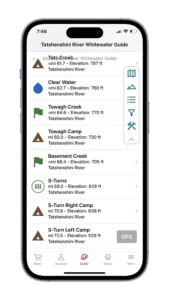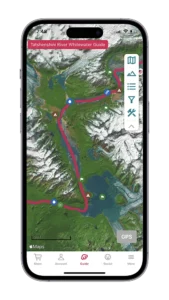About Alsek Lake
The entrance into Alsek Lake is one of the most unique rafting experiences you will find anywhere on the planet. The Grand Plateau and Alsek Glaciers descend from the heart of the Fairweather Range to water level, creating a massive lake within the Alsek drainage. Gateway Knob sits in the southwestern corner near the exit of the lake, providing groups with the most remarkable campsites on the drainage.
Depending on glacial activity, the lake can be relatively ice free, or so chocked full that navigation through would be impossible. In 2014 a near mile long section of the Grand Plateau Glacier calved off into the lake and slowly broke apart. For the entirety of that year the lake was 90% covered with icebergs. From 2015 to 2022 icebergs have been less present, but the potential for these events is always there.
While rafting into a lake sounds trivial, the Alsek presents unique challenges. Whatever icebergs are in the lake tend to get blown north, running aground and clustering around the entrance to the lake. Think of these icebergs as massive floating undercuts. At this point the Alsek is likely flowing between 90,000 and 250,000 CFS. Choosing a channel that funnels into a wall of icebergs would be catastrophic. Luckily there are several ways of entering to avoid that from happening.
The original Tat/Alsek guides labeled the different entrances to Alsek Lake Door 1, Door 2, and Door 3. From the scout, groups should be able to identify the doors and ask themselves the following questions; where is the water and where is the ice?
Door 1
Also known as the “Channel of Death”, Door 1 follows the main flow of the Alsek past Bear Island directly into the Lake. If there is any ice visible from the scout or your view is obstructed, choose a different door. The current here is swift with hidden gravel bars that can restrict your ability to maneuver away from the ice. Afternoon wind can also substantially affect your ability to make it to Gateway Knob.
Door 2
Door 2 follows the channel directly to the left of Long Island and hugs Gateway Knob along the Northeast side. If you want to raft into the lake as you approach the Gateway Knob campsite, this is the entrance you should take. While typically free from obstruction, icebergs will occasionally block this channel. If that is the case or you have any concern, choose Door 3.
Door 3
Door 3 flows to the right of both Long Island and Gateway Knob. This is an area of intense silt deposit making it too shallow for icebergs to enter. When in doubt, choose Door 3. There are a couple drawbacks to this entrance. Door 3 has the least amount of water and will be too low for rafts at certain times of the year. As of 2021, more water is entering Door 3 than in years past. On the surface, this is a nice change. However, the Door 3 channel sometimes exits closer to the lake exit rather than next to Gateway Knob, forcing groups to row against mild current back to the campsites.
The first commercial rafting trip of 2014 arrived at the scout to find the lake completely full of ice and very little water going through Door 3. They made the only choice available; float Door 3 as far as they could and undertake a massive portage to the Gateway Knob campsite. Although only 1.5 miles, portaging three completely de-rigged boats took 19 hours over a two days span with guides tallying up 30 miles of walking and schlepping. Although laborious, it was the only option available. That same year another commercial trip attempted to pick their way through the ice rather than portage Door 3. They were able to take Door 2 and break through, but could not get back to Gateway Knob. After several days of camping on the south side of the lake they were forced to call for a helicopter evacuation. These antidotes serve as a nice reminder that the Tatshenshini and Alsek is a wild and dynamic place that requires respect, preparation, and solid decision making.






